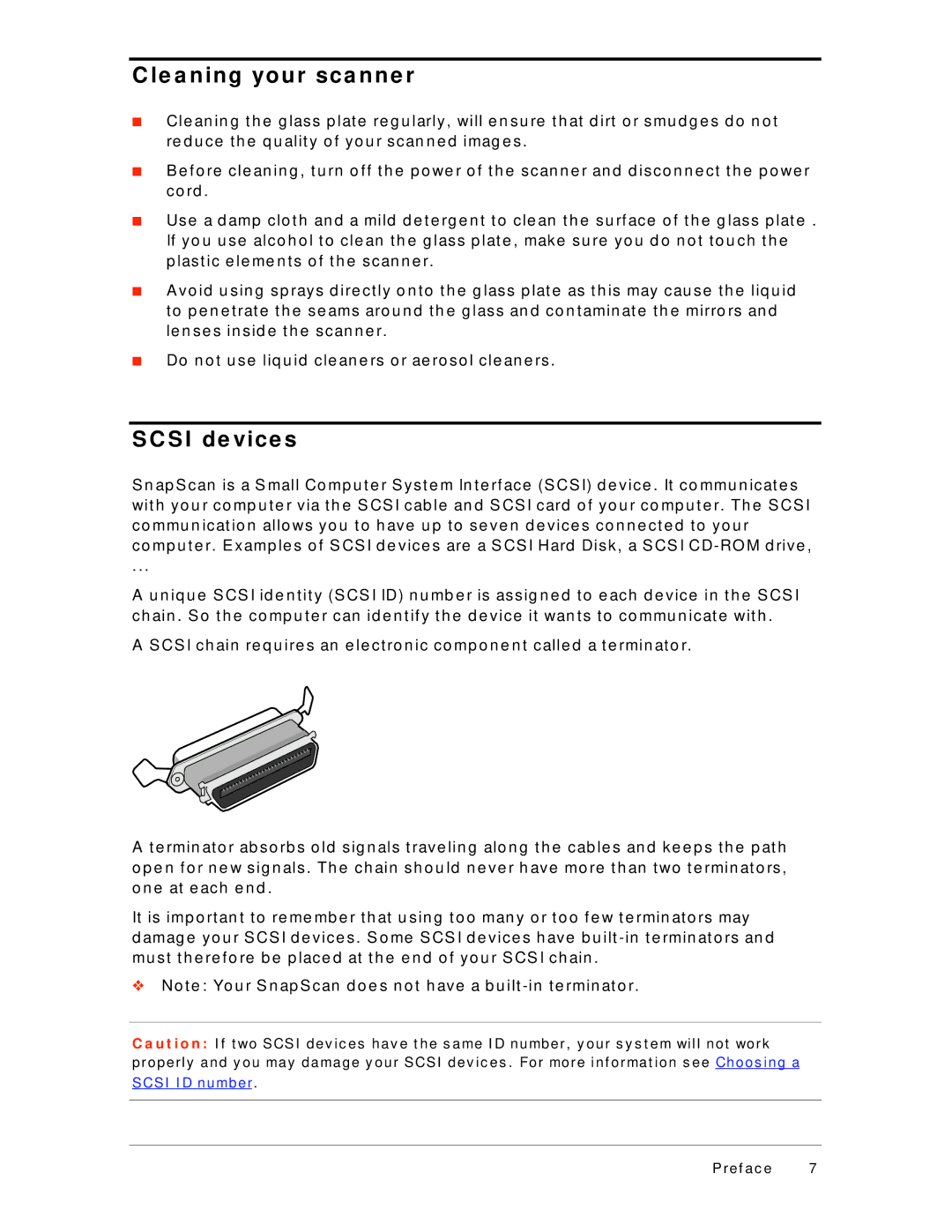
C le a ning your sca nne r
■ Cle an in g t h e g lass p lat e re g u larly, will e n su re t h at d irt o r smu d g e s d o n o t re d u ce t h e q u alit y o f yo u r scan n e d imag e s .
■B e f o re cle an in g , t u rn o f f t h e p o we r o f t h e scan n e r an d d isco n n e ct t h e p o we r co rd .
■ | Use a d amp clo t h an d a mild d e t e rg e n t t o cle an t h e su rf ace o f t h e g lass p lat e . |
| If yo u u se alco h o l t o cle an t h e g lass p lat e , make su re yo u d o n o t t o u ch t h e |
| p last ic e le me n t s o f t h e scan n e r. |
■ | A vo id u sin g sp rays d ire ct ly o n t o t h e g lass p lat e as t h is may cau se t h e liq u id |
| t o p e n e t rat e t h e se ams aro u n d t h e g lass an d co n t amin at e t h e mirro rs an d |
| le n se s in sid e t h e scan n e r. |
■Do n o t u se liq u id cle an e rs o r ae ro so l cle an e rs .
S C S I de vice s
S n ap S can is a S mall Co mp u t e r S yst e m In t e rf ace (S CS I) d e vice . It co mmu n icat e s wit h yo u r co mp u t e r via t h e S CS I cab le an d S CS I card o f yo u r co mp u t e r. Th e S CS I co mmu n icat io n allo ws yo u t o h ave u p t o se ve n d e vice s co n n e ct e d t o yo u r
co mp u t e r. E xamp le s o f S CS I d e vice s are a S CS I Hard Disk, a S CS I
. . .
A u n iq u e S CS I id e n t it y (S CS I ID) n u mb e r is assig n e d t o e ach d e vice in t h e S CS I ch ain . S o t h e co mp u t e r can id e n t if y t h e d e vice it wan t s t o co mmu n icat e wit h .
A S CS I ch ain re q u ire s an e le ct ro n ic co mp o n e n t calle d a t e rmin at o r.
A t e rmin at o r ab so rb s o ld sig n als t rave lin g alo n g t h e cab le s an d ke e p s t h e p at h o p e n f o r n e w sig n als . Th e ch ain sh o u ld n e ve r h ave mo re t h an t wo t e rmin at o rs, o n e at e ach e n d .
It is imp o rt an t t o re me mb e r t h at u sin g t o o man y o r t o o f e w t e rmin at o rs may
d amag e yo u r S CS I d e vice s . S o me S CS I d e vice s h ave b u ilt
❖No t e : Yo u r S n ap S can d o e s n o t h ave a b u ilt
C a u t i o n : I f t wo SCSI dev ic es hav e t he s ame I D number, y our s y s t em will not work properly and y ou may damage y our SCSI dev ic es . For more inf ormat ion s ee Choos ing a SCSI I D number .
P r e f a c e | 7 |
